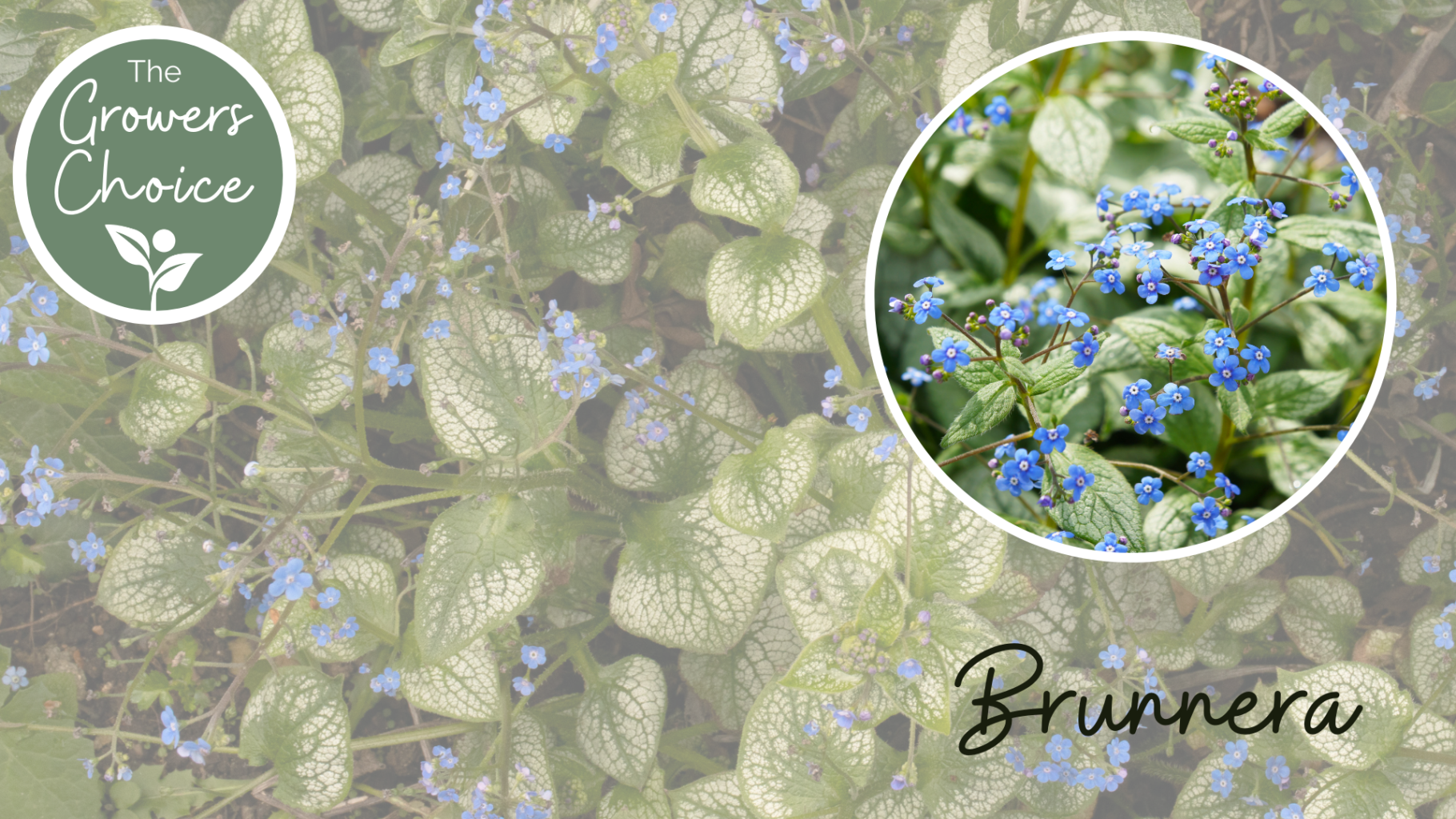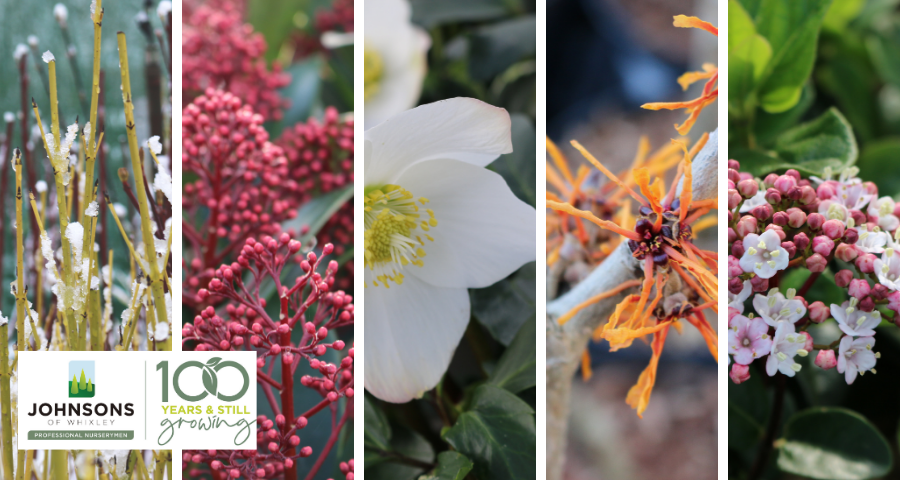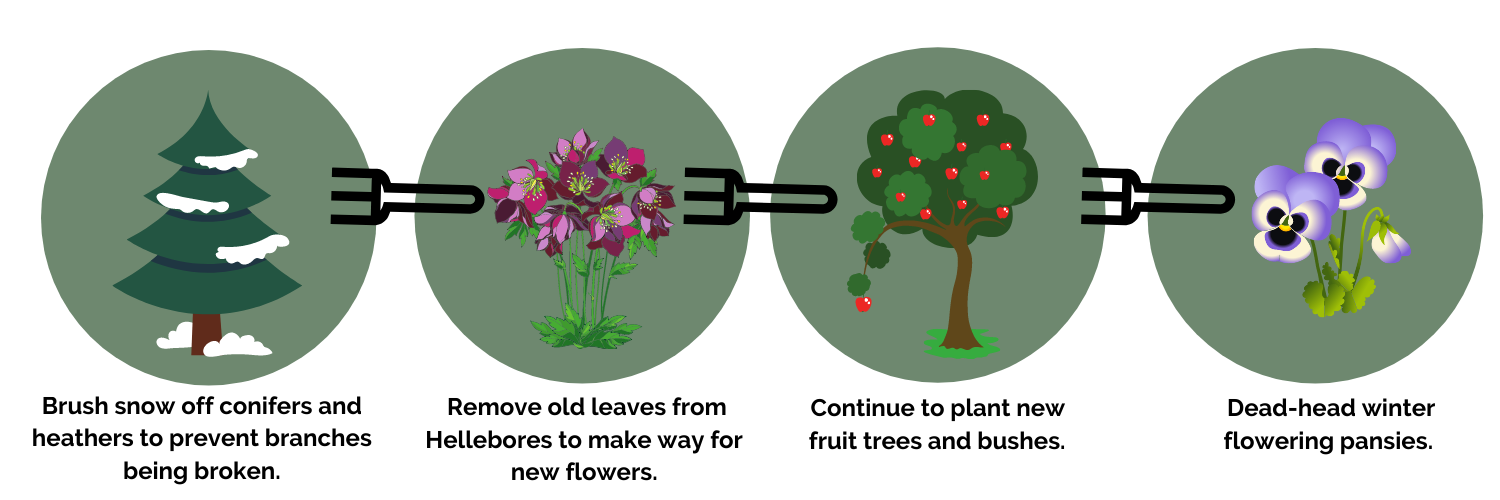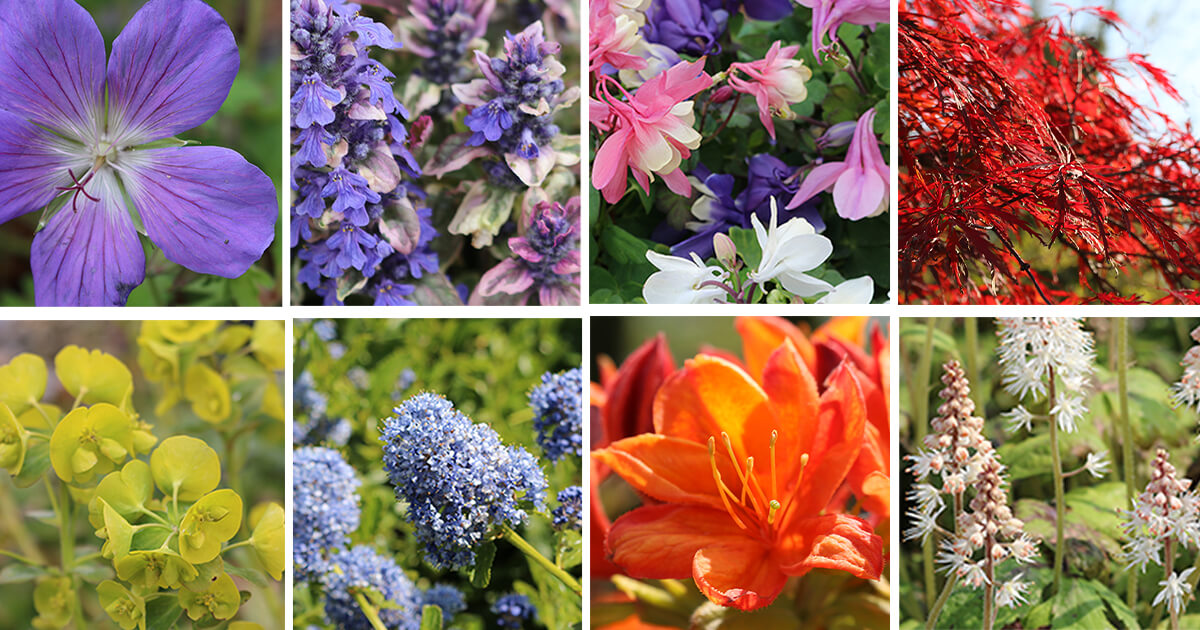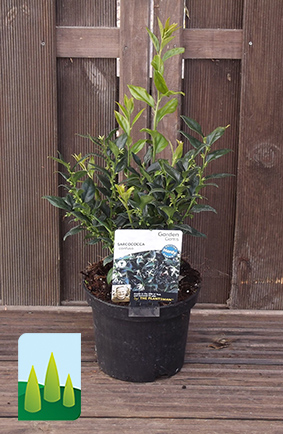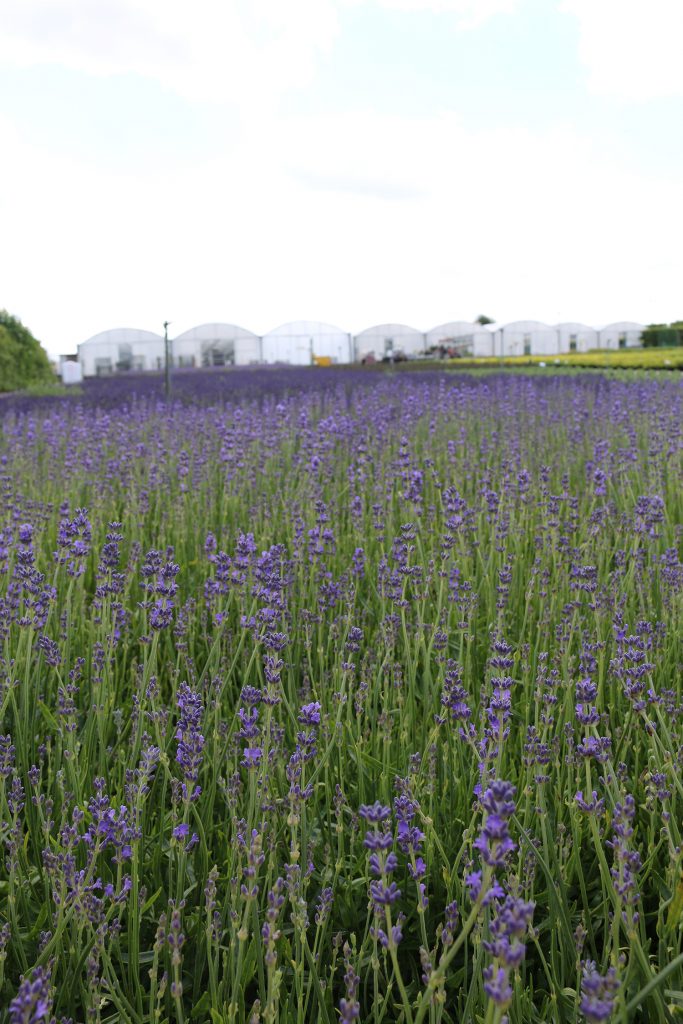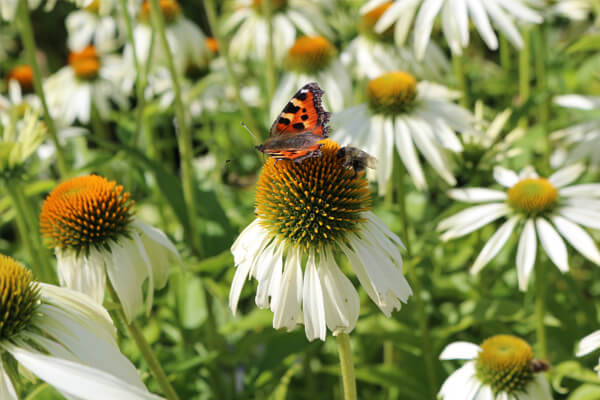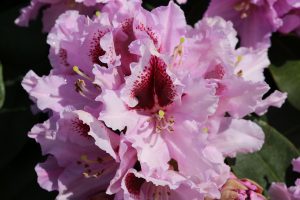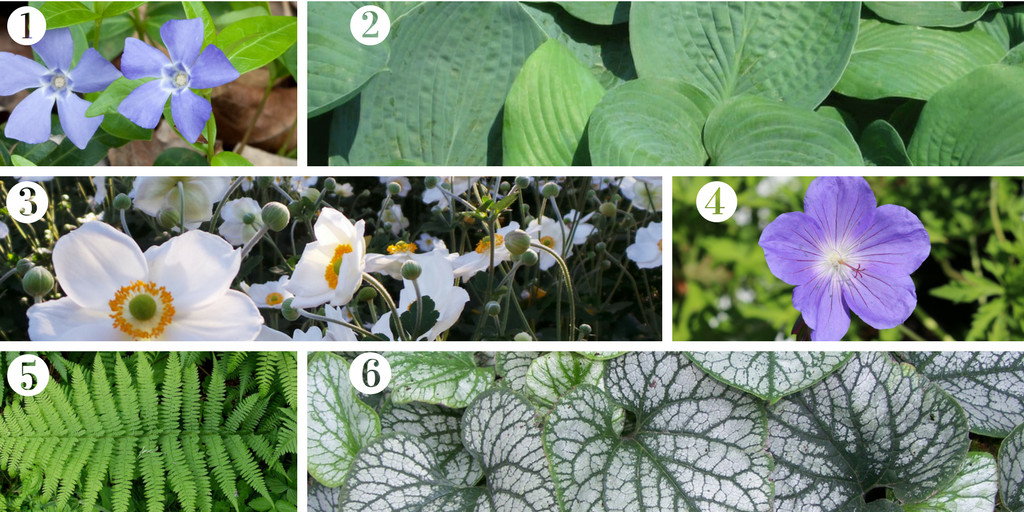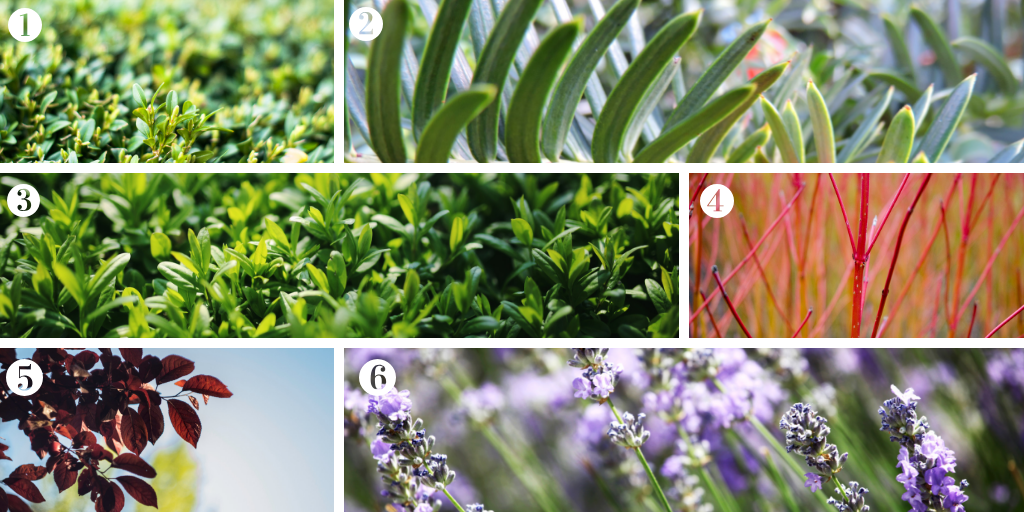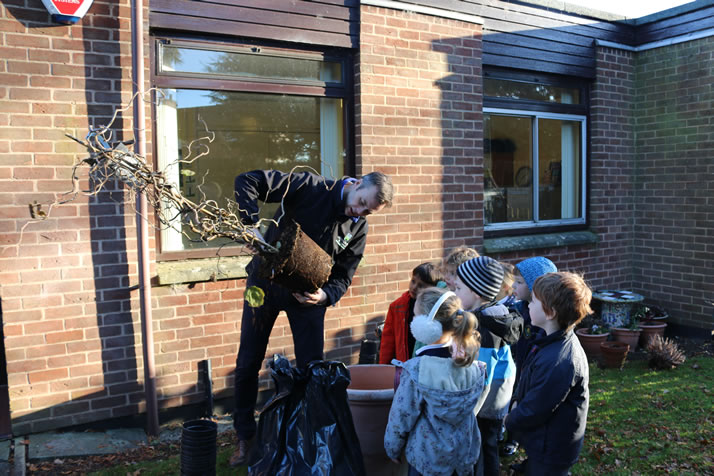April sees the garden starting to wake up, as more shrubs and herbaceous plants start to bloom including some Clematis. Pieris, Spirea and Brunnera varieties. Check out some of our favourite April flowering varieties below
Amelanchier lamarckii

Delicate star-shaped flowers appear in spring against bronze leaves that mature to dark green with great autumn interest.
 Flowers: March – April
Flowers: March – April
 Position: Full sun – partial shade
Position: Full sun – partial shade
 Height: Up to 10m depending on the variety
Height: Up to 10m depending on the variety
 Soil: fertile, moist but well-drained neutral to acid soil
Soil: fertile, moist but well-drained neutral to acid soil
 Pot size: 2L, 3L, 5L, 10L,12L + (subject to availability and the variety)
Pot size: 2L, 3L, 5L, 10L,12L + (subject to availability and the variety)
———————————————————————————————
Bergenia varieties such as ‘Silberlicht’ and cordifolia ‘Purpurea’

Bergenia’s large leathery leaves make attractive ground cover, while its flowers provide an early source of pollen for bees and other pollinating insects.
 Flowers: March – April
Flowers: March – April
 Position: Full sun – partial shade
Position: Full sun – partial shade
 Height: Up to 0.6m depending on the variety
Height: Up to 0.6m depending on the variety
 Soil: Any soil type
Soil: Any soil type
 Pot size: 2L, 3L (subject to availability and the variety)
Pot size: 2L, 3L (subject to availability and the variety)
———————————————————————————————
Brunnera varieties such as macrophylla ‘Jack Frost’

Tiny blue forget-me-not flowers appear against heart-shaped silver dusted leaves in spring. A beautiful groundcover plant for a shaded border.
 Flowers: April – May
Flowers: April – May
 Position: Partial shade
Position: Partial shade
 Height: Up to 0.4m depending on the variety
Height: Up to 0.4m depending on the variety
 Soil: Fertile, humus-rich, moist, well-drained soil
Soil: Fertile, humus-rich, moist, well-drained soil
 Pot size: 2L, 3L (subject to availability and the variety)
Pot size: 2L, 3L (subject to availability and the variety)
———————————————————————————————
Chaenomeles varieties such as ‘Jet Trail, ‘Crimson & Gold’ & ‘Nivalis’

A great addition to a wall or fence in the sun or partial shade-providing colour in early spring when little else is flowering. Flowers are available in pink, red and white.
 Flowers: March – May
Flowers: March – May
 Position: Full sun – partial shade
Position: Full sun – partial shade
 Height: Up to 2.5m
Height: Up to 2.5m
 Soil: Moderately fertile, moist but well-drained soil
Soil: Moderately fertile, moist but well-drained soil
 Pot size: 2L, 3L, 3LD, 5L (subject to availability and the variety)
Pot size: 2L, 3L, 3LD, 5L (subject to availability and the variety)
———————————————————————————————
Camellia varieties

Some of our Camellia plants are in full bud right now (start of February) this plant makes a great addition to a partially shaded border or large pot with luscious green foliage and flowers available in shades of pink, red and white.
 Flowers: February – April (depending on the variety)
Flowers: February – April (depending on the variety)
 Position: Partial shade (not east-facing)
Position: Partial shade (not east-facing)
 Height: Up to4m + (depending on the variety)
Height: Up to4m + (depending on the variety)
 Width: Up to 2.5m (depending on the variety)
Width: Up to 2.5m (depending on the variety)
 Soil: moist but well-drained, humus-rich, acid soil
Soil: moist but well-drained, humus-rich, acid soil
 Pot size: 2L, 3L, 5L, 7.5L, 10L, 20L + ( subject to availability and the variety)
Pot size: 2L, 3L, 5L, 7.5L, 10L, 20L + ( subject to availability and the variety)
———————————————————————————————
Clematis varieties such as ‘early sensation’

 Flowers: March – April
Flowers: March – April
 Position: Full sun – Partial shade
Position: Full sun – Partial shade
 Height: Up to 2m (depending on the variety)
Height: Up to 2m (depending on the variety)
 Width: Up to 2m (depending on the variety)
Width: Up to 2m (depending on the variety)
 Soil: Fertile, well drained soil
Soil: Fertile, well drained soil
 Pot size: 10L, 20L ( subject to availability and the variety)
Pot size: 10L, 20L ( subject to availability and the variety)
———————————————————————————————
Corylopsis pauciflora

Sweetly scented yellow flowers appear on bare stems during March and April gollowed by bronzed, hazel like leaves which mature to bright green.
 Flowers: March – April
Flowers: March – April
 Position: Partial shade
Position: Partial shade
 Height: Up to 1,5m (depending on the variety)
Height: Up to 1,5m (depending on the variety)
 Width: Up to 1.5m (depending on the variety)
Width: Up to 1.5m (depending on the variety)
 Soil: Fertile, moist, well drained ,acid soil
Soil: Fertile, moist, well drained ,acid soil
 Pot size: 10L, 20L ( subject to availability and the variety)
Pot size: 10L, 20L ( subject to availability and the variety)
———————————————————————————————
Choisya varieties such as ‘Aztec Pearl’, ‘Sundance’ & ‘White Dazzler’

 Flowers: April – May (often have a second flush in summer)
Flowers: April – May (often have a second flush in summer)
 Position: Full sun – partial shade
Position: Full sun – partial shade
 Height: Up to 2.5m
Height: Up to 2.5m
 Soil: Moderately fertile,well-drained soil
Soil: Moderately fertile,well-drained soil
 Pot size: 2L, 3L, 5L, 10L (subject to availability)
Pot size: 2L, 3L, 5L, 10L (subject to availability)
———————————————————————————————
Deutzia varieties like ‘Mont Rose’ and ‘Rosea’

 Flowers: April – June
Flowers: April – June
 Position: Full sun – partial shade
Position: Full sun – partial shade
 Height: Up to 1m
Height: Up to 1m
 Soil: Fertile, well-drained soil
Soil: Fertile, well-drained soil
 Pot size: 2L, 3L (depending on variety and subject to availability)
Pot size: 2L, 3L (depending on variety and subject to availability)
———————————————————————————————
Dicentra varieties such as ‘Bleeding Heart’

Heart-shaped flowers appear in spring above fern-like green leaves. Great in a shady border or as part of a cottage garden planting plan.
 Flowers: April – May
Flowers: April – May
 Position: Full sun or partial shade
Position: Full sun or partial shade
 Soil: Moist, humus-rich, preferably neutral to slightly alkaline
Soil: Moist, humus-rich, preferably neutral to slightly alkaline
 Pot size: Available in 2L and 3L pots subject to availability.
Pot size: Available in 2L and 3L pots subject to availability.
———————————————————————————————
Erysimum ‘Bowles’s mauve’

A long-flowering semi-evergreen with narrow, grey-green leaves. This perennial produces spikes of purple flowers from late February to July and will make a great addition to a long flowering sunny border.
 Flowers: February – July
Flowers: February – July
 Position: Full sun
Position: Full sun
 Soil: Fertile, well-drained, neutral soil
Soil: Fertile, well-drained, neutral soil
 Pot size: Available in 2L pots subject to availability.
Pot size: Available in 2L pots subject to availability.
———————————————————————————————
Euphorbia wulfenii

Is filled with huge heads of yellow-green flowers with ‘bronze eyes’ from late March-May that tower above its bluish-green foliage. Great at the back of a sunny border.
Available in 2L pots subject to availability.
 Flowers: Late March-May
Flowers: Late March-May
 Position: Full sun
Position: Full sun
———————————————————————————————
Exochorda x macrantha varieties such as ‘The Bride’ & ‘Niagara’

 Flowers: April – May
Flowers: April – May
 Position: Full sun – partial shade
Position: Full sun – partial shade
 Height: Up to 2m
Height: Up to 2m
 Soil: Moist, well-drained soil
Soil: Moist, well-drained soil
 Pot size: 2L, 5L (depending on variety and subject to availability)
Pot size: 2L, 5L (depending on variety and subject to availability)
———————————————————————————————
Forsythia ‘Lynwood Gold’
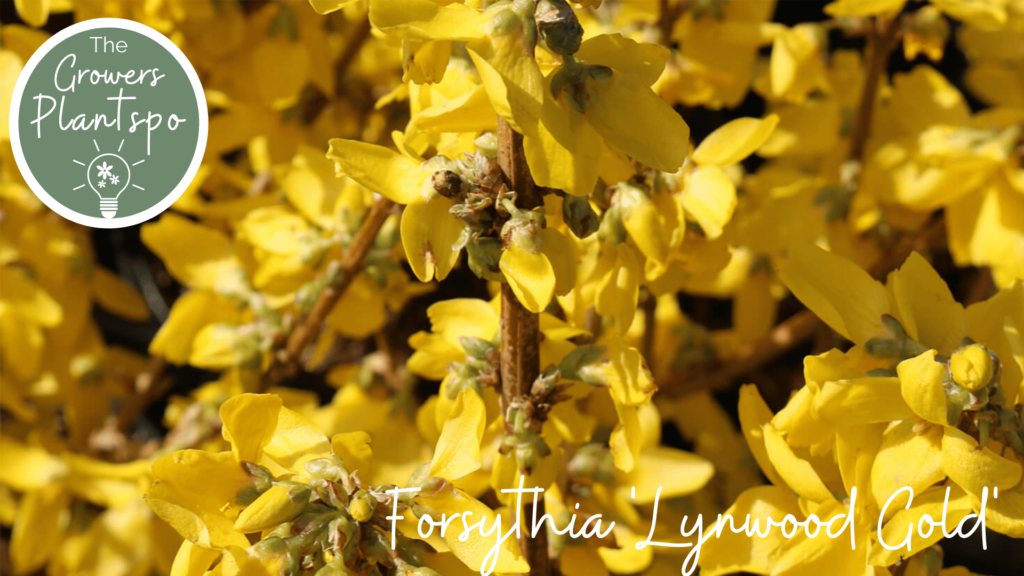
Yellow flowers smother branches from March – April providing a notable cheery sight to the start of spring. Try planting at the back of a dull border or even as a hedge with its full height reaching 2 meters.
 Flowers: February to April
Flowers: February to April
 Position: Full sun or light shade
Position: Full sun or light shade
 Soil: Fertile, moist, well-drained, neutral soil
Soil: Fertile, moist, well-drained, neutral soil
 Pot size: Available in 2L and 3L pots subject to availability.
Pot size: Available in 2L and 3L pots subject to availability.
———————————————————————————————
Kerria japonica ‘Pleniflora’

A great addition to the garden, brighting up a dark corner, with double yellow flowers that burst from mid-late spring.
 Flowers: March-May
Flowers: March-May
 Position: Full sun – partial shade
Position: Full sun – partial shade
 Height: Up to 2m
Height: Up to 2m
 Soil: Fertile, well-drained soil
Soil: Fertile, well-drained soil
 Pot size: 10L (depending on variety and subject to availability)
Pot size: 10L (depending on variety and subject to availability)
———————————————————————————————
Osmanthus x burkwoodii & delavayi

 Flowers: April-May
Flowers: April-May
 Position: Full sun – partial shade
Position: Full sun – partial shade
 Height: Up to 3m
Height: Up to 3m
 Soil: Fertile, well-drained soil
Soil: Fertile, well-drained soil
 Pot size: 2L, 3L, 5L 10L (depending on variety and subject to availability)
Pot size: 2L, 3L, 5L 10L (depending on variety and subject to availability)
———————————————————————————————
Prunus Kojo-no-Mai

A pretty deciduous shrub with zig-zag branches and crimson buds that open to display white flowers with pink centres in early spring. Its luscious green leaves appear after the summer months and are then followed by bright reddish/orange leaves before falling in the Autumn. A perfect small compact tree for a smaller garden or patio pot.
 Flowers: March-April
Flowers: March-April
 Position: Full sun
Position: Full sun
 Height: Up to 2m
Height: Up to 2m
 Soil: Fertile, well-drained soil
Soil: Fertile, well-drained soil
 Pot size: 10L (depending on variety and subject to availability)
Pot size: 10L (depending on variety and subject to availability)
———————————————————————————————
Magnolia x soulangeana and the variety ‘Susan’

Another sign that spring is on its way… Magnolias in bud, these varieties generally flower from March-April onwards but some may appear towards the end of February.
 Flowers: March – April onwards
Flowers: March – April onwards
 Position: Full sun or partial shade (depending on the variety)
Position: Full sun or partial shade (depending on the variety)
 Height: Up to 10m (depending on variety)
Height: Up to 10m (depending on variety)
 Soil: Moist-well-drained, acidic soil
Soil: Moist-well-drained, acidic soil
 Pot size: 2L, 3L, 5L, 10L (depending on variety and subject to availability)
Pot size: 2L, 3L, 5L, 10L (depending on variety and subject to availability)
———————————————————————————————
Pieris varieties such as ‘Passion’

Pieris plants generally flower from March-May but buds start to appear in February. Ideal for a partially shaded shrub border with flowers resembling lily-of-the-valley and available in shades of pink, red and white.
 Position: Full sun – partial shade
Position: Full sun – partial shade
 Flowers: March-May (depending on variety)
Flowers: March-May (depending on variety)
 Height: Up to 2.5m (depending on the variety)
Height: Up to 2.5m (depending on the variety)
 Width: Up to 2m (depending on the variety)
Width: Up to 2m (depending on the variety)
 Soil: humus-rich, moist, well-drained acid soil or ericaceous compost
Soil: humus-rich, moist, well-drained acid soil or ericaceous compost
 Pot size: 2l, 3L, 5L, 7.5L, 10L, 20L (depending on the variety and availability)
Pot size: 2l, 3L, 5L, 7.5L, 10L, 20L (depending on the variety and availability)
———————————————————————————————
Ribes sanguineum varieties such as ‘King Edward’, ‘Pulborough Scarlet’

 Flowers: April – May
Flowers: April – May
 Position: Full sun
Position: Full sun
 Height: Up to 3m depending on the variety
Height: Up to 3m depending on the variety
 Soil: Moderately fertile, moist, well-drained soil
Soil: Moderately fertile, moist, well-drained soil
 Pot size: 2L, 2LD, 3L, 3LD, 5L, 10L (depending on variety and subject to availability)
Pot size: 2L, 2LD, 3L, 3LD, 5L, 10L (depending on variety and subject to availability)
———————————————————————————————
Salix varieties with catkins such as ‘Mount Aso’

Fuzzy pink catkins appear on varieties such as ‘Mount Aso’ during late winter – early spring, a wonderful eye-catching addition to the garden.
 Position: Full sun
Position: Full sun
 Flowers: April – May
Flowers: April – May
 Height: Up to 4m (depending on the variety)
Height: Up to 4m (depending on the variety)
 Width: Up to 3m (depending on the variety)
Width: Up to 3m (depending on the variety)
 Soil: Moist but well-drained soil
Soil: Moist but well-drained soil
 Pot size: 2L, 3LD, 5L, 10L ( subject to availability and the variety)
Pot size: 2L, 3LD, 5L, 10L ( subject to availability and the variety)
———————————————————————————————
Skimmia varieties such as ‘Rubella’ and ‘Kew Green’

Are you in need of some autumn/winter colour? Skimmia Rubella are known for their dark red flower buds that are produced in autumn and last through to winter until the flowers open in spring — an excellent plant for a patio pot or border.
 Flowers: End of March – May (depending on variety and whether its a male or female cultivar) flower buds are seen in autumn-winter.
Flowers: End of March – May (depending on variety and whether its a male or female cultivar) flower buds are seen in autumn-winter.
 Position: Partial – full shade
Position: Partial – full shade
 Height: Up to 1.5m (depending on variety)
Height: Up to 1.5m (depending on variety)
 Soil: Moist-well-drained, acid soil
Soil: Moist-well-drained, acid soil
 Pot size: 2L, 3L, 5L, 10L (depending on variety and subject to availability)
Pot size: 2L, 3L, 5L, 10L (depending on variety and subject to availability)
———————————————————————————————
Viburnum varieties such as ‘tinus’ and ‘bod Dawn’

Evergreen Viburnums such as tinus are a great shrub for winter interest with dark green leaves and clusters of tiny white flowers from December to April.
A great low maintenance, easy to grow shrub that can brighten a part shaded area of the garden when little else is flowering.
 Flowers: December – April
Flowers: December – April
 Position: Full sun or partial shade
Position: Full sun or partial shade
 Height: Up to 3m (depending on variety)
Height: Up to 3m (depending on variety)
 Soil: Fertile, moist-well-drained soil
Soil: Fertile, moist-well-drained soil
 Pot size: 2L, 3L, 5L, 10L (depending on variety and subject to availability)
Pot size: 2L, 3L, 5L, 10L (depending on variety and subject to availability)
———————————————————————————————
Vinca varieties such as ‘major’, minor’ and ‘atropurpurea’

A great low growing ground cover plant with pale blue flowers and lance-shaped dark green leaves. It is excellent at suppressing weeds and would make a great addition to the front of a border. It generally flowers from April – September.
 Flowers: End of March- April – September
Flowers: End of March- April – September
 Position: Full sun – partial shade
Position: Full sun – partial shade
 Height: Up to 0.45m depending on the variety
Height: Up to 0.45m depending on the variety
 Soil: any but very dry soil
Soil: any but very dry soil
 Pot size: 2L, 3L, 5L (depending on variety and subject to availability)
Pot size: 2L, 3L, 5L (depending on variety and subject to availability)
Click here for more monthly plantspo
![]() Keep control of soft, fast-growing weeds such as thistles; they harbour aphids and other problems.
Keep control of soft, fast-growing weeds such as thistles; they harbour aphids and other problems.![]() Now is the time to make yourself a good big compost bin, just before you really need it! Ideally, use four stakes as corners 1 metre apart in a square and staple wire netting (1 metre deep) around the square. This affords easy entry when you wish to empty it, or it can be made bigger or smaller at will. If you would like a really permanent one, use pressure-treated plywood or boards instead of netting.
Now is the time to make yourself a good big compost bin, just before you really need it! Ideally, use four stakes as corners 1 metre apart in a square and staple wire netting (1 metre deep) around the square. This affords easy entry when you wish to empty it, or it can be made bigger or smaller at will. If you would like a really permanent one, use pressure-treated plywood or boards instead of netting.![]() Treat shrubs which were cut back in the spring with a high Sulphate of Potash feed to encourage the production of flower buds for next year. Prune shrubs grown on walls and pergolas to remove some of the top growth and further stimulate growth from the base of the plant.
Treat shrubs which were cut back in the spring with a high Sulphate of Potash feed to encourage the production of flower buds for next year. Prune shrubs grown on walls and pergolas to remove some of the top growth and further stimulate growth from the base of the plant.![]() Evergreen hedges can be clipped this month (and some deciduous ones), but ensure there are no nesting birds in the hedge or bush. Cut laurel, and Eleagnus hedges with secateurs to prevent cut leaves. In hot weather, spray newly planted container-grown hedge plant foliage with water as well as ensuring that the root zone continues to be kept moist.
Evergreen hedges can be clipped this month (and some deciduous ones), but ensure there are no nesting birds in the hedge or bush. Cut laurel, and Eleagnus hedges with secateurs to prevent cut leaves. In hot weather, spray newly planted container-grown hedge plant foliage with water as well as ensuring that the root zone continues to be kept moist.![]() Lift tulip bulbs after they have fully died down and store them in paper bags in a dry and airy place over the summer.
Lift tulip bulbs after they have fully died down and store them in paper bags in a dry and airy place over the summer.![]() Keep hydrangeas well-watered, particularly those growing in containers, as they quickly show signs of drought, and it can be difficult to get them to fully recover.
Keep hydrangeas well-watered, particularly those growing in containers, as they quickly show signs of drought, and it can be difficult to get them to fully recover.![]() Check the moisture level of hanging baskets every morning, and water thoroughly if dry. Feed plants with a soluble or liquid feed once per week and remove flower heads which are going over.
Check the moisture level of hanging baskets every morning, and water thoroughly if dry. Feed plants with a soluble or liquid feed once per week and remove flower heads which are going over.![]() Divide established clumps of bearded iris immediately after blooming and plant in the ground or in containers and keep moist. Discard the older exhausted rhizomes, and cut back the foliage of the new plants to approximately 12-15cm.
Divide established clumps of bearded iris immediately after blooming and plant in the ground or in containers and keep moist. Discard the older exhausted rhizomes, and cut back the foliage of the new plants to approximately 12-15cm.![]() Lawns may have turned brown in the very dry weather we had in June, but if it rains significantly in the near future, the lawn will quickly green up again. If it remains dry, leave grass mowings on the lawn to act as a mulch. Remove significant weeds, as these will quickly outgrow the surrounding grass.
Lawns may have turned brown in the very dry weather we had in June, but if it rains significantly in the near future, the lawn will quickly green up again. If it remains dry, leave grass mowings on the lawn to act as a mulch. Remove significant weeds, as these will quickly outgrow the surrounding grass.![]() Roses will appreciate a good soak in the dry weather, remove spent flowerheads and ensure that greenflies are not becoming established on the younger shoots. Apply a summer rose feed in mid-month.
Roses will appreciate a good soak in the dry weather, remove spent flowerheads and ensure that greenflies are not becoming established on the younger shoots. Apply a summer rose feed in mid-month.![]() Before hose watering during the summer, ensure that your region has not had watering restrictions imposed, as water resources appear to have become under stress much earlier in the summer than usual.
Before hose watering during the summer, ensure that your region has not had watering restrictions imposed, as water resources appear to have become under stress much earlier in the summer than usual.![]() In dry weather, an effective way of reducing moisture loss on bare ground between plants is to hoe the ground lightly to maintain a loose tilth, but don’t hoe too deeply. Another good aid in very dry conditions is to apply a 2-3cm mulch of garden compost to the soil surface.
In dry weather, an effective way of reducing moisture loss on bare ground between plants is to hoe the ground lightly to maintain a loose tilth, but don’t hoe too deeply. Another good aid in very dry conditions is to apply a 2-3cm mulch of garden compost to the soil surface.![]() Prune or tie in shrubs growing on walls or pergolas to secure some of the heavy top growth and further stimulate additional growth from the lower regions of the plant.
Prune or tie in shrubs growing on walls or pergolas to secure some of the heavy top growth and further stimulate additional growth from the lower regions of the plant.![]() Give the root balls of newly purchased container-grown shrubs and trees a really good soaking before planting and again 5 or 6 days later after planting. Ensure that stakes remain secure after the wind.
Give the root balls of newly purchased container-grown shrubs and trees a really good soaking before planting and again 5 or 6 days later after planting. Ensure that stakes remain secure after the wind.![]() July is a good month to take Heather cuttings, choose strong, young, half-ripe, non-flowering shoots, and dip the bottom 5cm in rooting hormone. Insert around the edge of a 9cm pot. Keep in a closed-shaded area, and don’t allow it to dry out, but don’t allow drips from covering glass to fall on them!
July is a good month to take Heather cuttings, choose strong, young, half-ripe, non-flowering shoots, and dip the bottom 5cm in rooting hormone. Insert around the edge of a 9cm pot. Keep in a closed-shaded area, and don’t allow it to dry out, but don’t allow drips from covering glass to fall on them!







 Prune strong growing Buddleias down to about 45cm. for a good show in the summer. Prune down to 60-80cm for denser but weaker overall growth.
Prune strong growing Buddleias down to about 45cm. for a good show in the summer. Prune down to 60-80cm for denser but weaker overall growth.






 Height: Up to 75cm
Height: Up to 75cm Soil: Most soil types, except dry or boggy conditions
Soil: Most soil types, except dry or boggy conditions








 Flowers: May – June
Flowers: May – June Position: Full sun
Position: Full sun



 Position: Full sun or partial shade
Position: Full sun or partial shade






















 Position: Full sun – partial shade
Position: Full sun – partial shade Height: Up to 3m (depending on the variety)
Height: Up to 3m (depending on the variety)











 Position: Full sun – partial shade
Position: Full sun – partial shade













 Flowers: End of March- April – September
Flowers: End of March- April – September










 Soil: well-drained soil
Soil: well-drained soil



































































































































